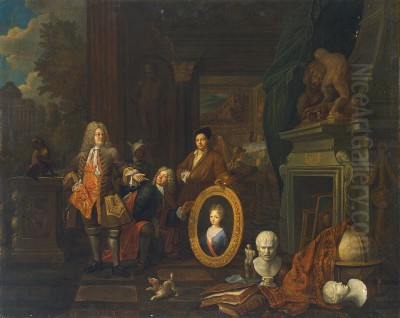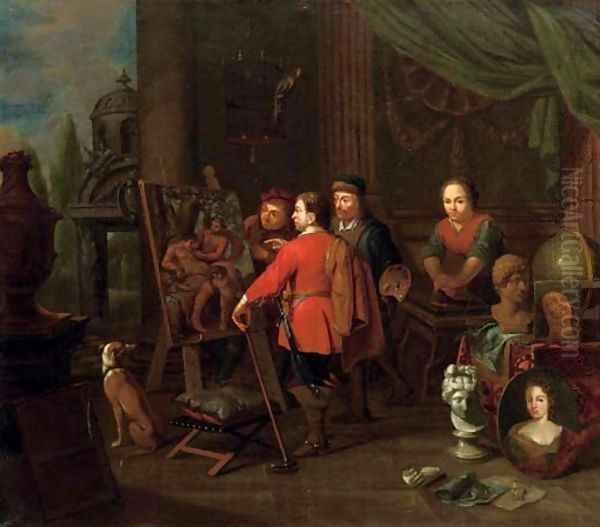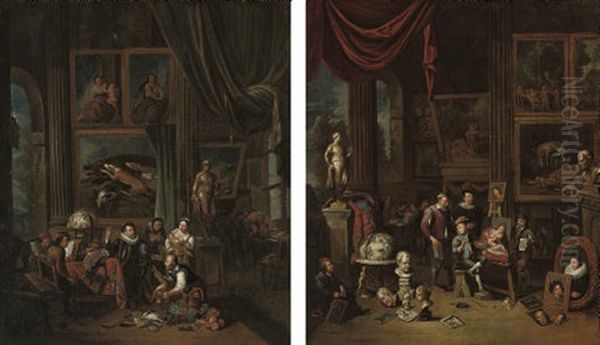
Balthasar van den Bossche stands as a fascinating figure in the landscape of Flemish painting during the transition from the late Baroque to the early Rococo period. Born in Antwerp in 1681 and passing away prematurely in 1715, his relatively short career was marked by a distinct focus on specific genre scenes: the bustling interiors of artists' studios and the opulent displays within noble picture galleries, often referred to as 'kunstkamers'. Through these works, Van den Bossche offered a valuable window into the world of art creation, collection, and appreciation in the early 18th century.
His paintings are more than mere depictions; they are carefully constructed narratives reflecting the social aspirations, intellectual pursuits, and aesthetic tastes of his time. He captured the milieu of artists, patrons, and connoisseurs, embedding his scenes with details that spoke of wealth, learning, and the high status accorded to the arts. While perhaps not reaching the towering fame of Antwerp's earlier masters like Peter Paul Rubens or Anthony van Dyck, Van den Bossche carved a significant niche for himself, becoming a sought-after painter whose works were appreciated both in his native Flanders and internationally, particularly in France.
Early Life and Artistic Formation in Antwerp
Balthasar van den Bossche was baptized in Antwerp on 29 January 1681. He entered the world during a period when the unparalleled artistic dynamism of Antwerp's Golden Age, dominated by figures like Rubens, Van Dyck, and Jacob Jordaens, had passed. However, the city remained an important artistic center with a strong tradition of craftsmanship and established guilds. It was within this environment that the young Van den Bossche began his artistic training.
His primary master was Gerard Thomas (1663-1720), a fellow Antwerp painter who himself specialized in depicting studio interiors and alchemist laboratories. This apprenticeship was crucial in shaping Van den Bossche's thematic interests and stylistic approach. Thomas's influence is evident in Van den Bossche's choice of subject matter and his meticulous attention to the details of interior spaces, objects, and figures engaged in artistic or scholarly activities.

Van den Bossche proved to be a talented pupil. His skill developed rapidly, and in 1697, at the young age of about 16 or 17, he was registered as a master in the prestigious Antwerp Guild of Saint Luke. This relatively early acceptance into the guild signifies his recognized competence and the successful completion of his training under Thomas. Becoming a master allowed him to establish his own workshop, take on pupils, and sell his work independently.
The artistic environment in Antwerp at this time still bore the strong imprint of 17th-century traditions. The legacy of David Teniers the Younger (1610-1690), particularly his popular depictions of peasant life, alchemists, and guardroom scenes, as well as his pioneering work in painting picture galleries, provided a rich backdrop. While Van den Bossche focused on more elegant and refined settings than Teniers's rustic scenes, the precedent for depicting interiors filled with objects and figures was well established.
Parisian Sojourn and Rising Reputation
Around the year 1700, seeking broader opportunities and perhaps a more cosmopolitan clientele, Balthasar van den Bossche moved to Paris. France, under Louis XIV, was the dominant cultural and political power in Europe, and its capital was a magnet for artists seeking patronage and prestige. Van den Bossche established a workshop in Paris and continued to develop his signature style.
His move proved successful. His detailed and elegant depictions of artists' studios and collectors' galleries resonated with the tastes of the French aristocracy and bourgeoisie. These paintings, often relatively small in scale but rich in detail and narrative potential, found a ready market. They offered viewers a glimpse into the refined world of art and connoisseurship, celebrating both the artist's skill and the patron's sophisticated taste.
During his time in Paris, Van den Bossche gained significant patronage. One of his most notable patrons was John Churchill, the 1st Duke of Marlborough, a prominent English general and statesman who was frequently on the continent due to the War of the Spanish Succession (1701-1714). Marlborough commissioned Van den Bossche to paint his portrait, a testament to the painter's growing reputation and his ability to attract high-profile clients. This connection also highlights the international network of artists and patrons operating across Europe at the time.

The War of the Spanish Succession itself may have indirectly influenced some of Van den Bossche's work. Some sources suggest he painted designs for war banners, and his occasional inclusion of military paraphernalia like armour and trophies in his gallery scenes might reflect the martial preoccupations of the era, alongside the more common symbols of art and learning. His time in Paris exposed him to the developing Rococo sensibilities, although his style remained rooted in his Flemish training, characterized by detailed realism rather than the lighter, more fluid brushwork associated with French artists like Antoine Watteau (1684-1721).
Artistic Style: Detail, Elegance, and Narrative
Balthasar van den Bossche's style is characterized by meticulous detail, careful composition, and a smooth, refined finish. He inherited from Gerard Thomas a love for rendering the textures of fabrics, the sheen of metal, the grain of wood, and the diverse objects that populated his chosen scenes. His works often feature a warm color palette and careful attention to light and shadow, used to create a sense of depth and highlight key elements within the composition.
His paintings are typically populated by elegantly dressed figures – artists, patrons, connoisseurs, assistants, and visitors. These figures are often engaged in activities related to art: painting, sculpting, examining artworks, discussing pieces, or simply inhabiting the space surrounded by cultural artefacts. The poses and interactions are generally calm and composed, contributing to an atmosphere of refined activity and intellectual engagement.
Van den Bossche excelled at creating complex interior spaces. His studios and galleries are filled with a profusion of objects: easels, palettes, brushes, canvases (often showing works in progress or copies of famous paintings), classical sculptures and plaster casts, globes, maps, books, musical instruments, scientific apparatus, luxurious furniture, and rich draperies. These elements are not merely decorative; they function as symbols of the activities taking place and the status and interests of the inhabitants.
Compared to his master, Gerard Thomas, Van den Bossche's works sometimes display an even greater density of objects and a slightly more decorative sensibility, perhaps reflecting the burgeoning Rococo taste he encountered in Paris. However, he maintained a commitment to naturalistic representation, carefully observing and rendering the details of the world he depicted. His technique involved precise drawing and the application of thin layers of paint to achieve a smooth, enamel-like surface.
The Artist's Studio Genre
One of Van den Bossche's signature subjects was the artist's studio. These paintings provide invaluable insights into the working practices and self-perception of artists in the early 18th century. They often depict the artist at the easel, sometimes accompanied by pupils, patrons, or elegant visitors. The studio itself is presented as a place of both skilled labor and intellectual activity.
In works like An Artist's Studio (examples exist in various collections), Van den Bossche typically includes elements that signify the different facets of artistic practice. The presence of plaster casts of classical sculptures points to the importance of studying antiquity, a cornerstone of academic art training. Books and globes might suggest the artist's learning and worldliness, while musical instruments could allude to the harmony between the arts or simply the refined atmosphere of the studio.
These studio scenes often served to elevate the status of the artist. By depicting the studio as a well-ordered, sophisticated space frequented by discerning patrons, Van den Bossche countered the older perception of the artist as a mere manual laborer. Instead, he presented the artist as a gentleman, a man of skill, taste, and intellect, participating in the cultural life of the elite. This aligns with a broader trend since the Renaissance, where artists sought to improve their social standing.
The figures within these studios often interact in ways that suggest narratives. A patron might be shown examining a finished work, while the artist gestures towards it, perhaps explaining its merits. Pupils might be seen grinding pigments or sketching, indicating the process of training and the transmission of knowledge. These vignettes add life and interest to the detailed settings.
The Picture Gallery or 'Kunstkamer'
Equally important to Van den Bossche's oeuvre are his depictions of picture galleries or 'kunstkamers'. This genre, which had flourished in Antwerp in the 17th century with painters like Willem van Haecht (1593-1637) and David Teniers the Younger, involved portraying real or imaginary collections of art and curiosities, often displayed within luxurious interiors. Van den Bossche continued this tradition into the 18th century.
His gallery paintings, such as A Nobleman's Picture Gallery, showcase rooms densely hung with paintings, reflecting the collecting habits of the aristocracy and wealthy bourgeoisie. These depicted paintings often represent various genres – history painting, portraiture, landscape, still life – creating a microcosm of the art world within the painting itself. Identifying the specific paintings shown can sometimes be challenging, as they might be copies, variations, or imaginary works in the style of famous masters.
Beyond paintings, these galleries are filled with other signifiers of wealth and culture: sculptures, elaborate furniture, oriental carpets, globes, scientific instruments, and sometimes exotic objects. The figures populating these scenes are typically connoisseurs, collectors, and their companions, shown admiring and discussing the artworks. Their elegant attire and refined postures emphasize the exclusivity and sophistication of the collecting world.
These paintings celebrated the collector's taste, wealth, and knowledge. Owning such a diverse and high-quality collection was a mark of social distinction and cultural refinement. Van den Bossche's detailed renderings allowed patrons to showcase their (real or idealized) possessions and assert their status. The genre also implicitly commented on art theory, connoisseurship, and the value placed on art in society. He follows in the footsteps of earlier Flemish painters like Gonzales Coques (1614/18-1684) and Hieronymus Janssens (1624-1693) who depicted elegant companies often surrounded by art.
Themes of Knowledge, Wealth, and Science
Across both studio and gallery scenes, Van den Bossche consistently weaves in themes of knowledge, wealth, and intellectual pursuit. The recurring presence of globes, maps, books, and scientific instruments points to the era's burgeoning interest in exploration, learning, and the sciences. These objects are placed alongside artworks, suggesting a holistic view of culture where art and science are complementary aspects of human achievement.
The depiction of luxurious settings, fine clothing, and abundant art objects clearly speaks to the theme of wealth and status. These paintings functioned, in part, as displays of material success and social standing for the patrons who commissioned or purchased them. The ability to patronize artists and assemble significant collections was a key marker of elite identity.
Van den Bossche also showed a specific interest in the intersection of art and science, particularly alchemy or early chemistry. This is most evident in his painting The Iatrochemist. Iatrochemistry was an early branch of chemistry that aimed to provide chemical solutions to medical problems. The painting depicts a scholar or practitioner in a laboratory setting, surrounded by the apparatus of his trade – vials, retorts, furnaces, and books.
This interest connects him not only to his master Gerard Thomas, who also painted alchemists, but also to a broader tradition in Netherlandish art represented by figures like Adriaen Brouwer (1605/06-1638), Joos van Craesbeeck (c.1605/06-c.1660), David Teniers the Younger, and later artists like Thomas Wijck (1616-1677) and Cornelis Bega (1631/32-1664). While some depictions of alchemists were satirical, Van den Bossche's portrayal in The Iatrochemist seems more focused on the scholarly and experimental aspects of the practice, presenting it as a serious intellectual endeavor.
Pupils and Workshop
As a master in the Guild of Saint Luke, Balthasar van den Bossche was entitled to take on pupils. Archival records indicate that he did train apprentices, although information about his workshop practices remains limited. Two pupils specifically mentioned in relation to him are Anthony Claesz and Johannes Baer. Unfortunately, little is widely known about the subsequent careers of these individuals, making it difficult to assess Van den Bossche's direct impact as a teacher.
The mention in some sources of Jan Davidsz. de Heem (1606-1683/84) as a student is chronologically impossible, as De Heem was a highly established master of still life painting long before Van den Bossche was even born. This likely represents a confusion or error in the historical record or its transmission. Similarly, while the legacy of the Bosschaert family, particularly Ambrosius Bosschaert the Elder (1573-1621), was significant for Flemish still life, there is no credible evidence linking Balthasar van den Bossche directly to this earlier dynasty as a pupil. His primary documented teacher remains Gerard Thomas.
His studio scenes, however, often depict the master-pupil relationship, showing young assistants grinding pigments, sketching, or receiving instruction. These depictions offer a generalized view of workshop life, emphasizing the transmission of artistic skill and knowledge from one generation to the next, a fundamental aspect of the guild system.
Later Years and Legacy
Balthasar van den Bossche's promising career was cut short by his early death in Antwerp on 15 September 1715, at the age of only 34. The exact circumstances of his death are not widely documented. His relatively brief period of activity, spanning less than two decades as an independent master, means his oeuvre is not as extensive as that of artists with longer careers.
Despite its brevity, his career was impactful. He successfully adapted the established Flemish genres of studio interiors and picture galleries to the tastes of the early 18th century. His works were popular during his lifetime, finding patrons in Antwerp, Paris, and beyond, as evidenced by the commission from the Duke of Marlborough. His paintings continued to be appreciated after his death and entered numerous important collections.
Today, works by Balthasar van den Bossche can be found in major museums around the world, including the Louvre Museum in Paris, the Hermitage Museum in St. Petersburg, and various institutions in Belgium, the Netherlands, Germany, and elsewhere. His paintings are valued for their detailed execution, their charm, and the fascinating glimpse they offer into the art world of his time.
He represents an important link in the tradition of Flemish genre painting, carrying forward the legacy of artists like Teniers and adapting it to new sensibilities. While the Antwerp school was generally considered to be in decline after the brilliance of the 17th century, Van den Bossche demonstrated that high levels of technical skill and appealing subject matter could still find success.
His focus on the 'kunstkamer' genre provides valuable documentation, albeit sometimes idealized, of collecting practices and the types of objects valued by the elite. His studio scenes contribute to our understanding of artistic training and the evolving social status of the artist. While detailed information about his personal life remains scarce – standard sources do not confirm details about marriage or children – his artistic legacy is clear and significant within his specific niche.
Conclusion: A Refined Observer
Balthasar van den Bossche remains a compelling figure in early 18th-century Flemish art. As a pupil of Gerard Thomas, he mastered the art of the detailed interior scene, specializing in the worlds of the artist and the collector. His move to Paris broadened his horizons and brought him prestigious patronage, confirming the appeal of his meticulous style and engaging subject matter.
Through his depictions of artists' studios and noble picture galleries, Van den Bossche celebrated the intertwined values of skill, knowledge, taste, and wealth that characterized the cultural elite of his time. His works are more than just records; they are carefully composed arguments for the importance of art and the elevated status of those who create and appreciate it. His inclusion of scientific and musical elements further enriched his narratives, presenting a holistic view of contemporary culture.
Though his life was cut tragically short, Balthasar van den Bossche left behind a body of work that continues to fascinate viewers with its intricate detail, elegant figures, and evocative portrayal of a specific historical milieu. He stands as a testament to the enduring strength of the Antwerp painting tradition and its ability to adapt and find new modes of expression even as the towering figures of its Golden Age receded into the past. His paintings remain valuable documents and charming works of art, securing his place as a significant minor master of the late Baroque era.